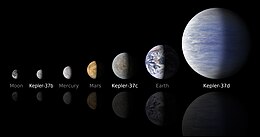Kepler-37
Coordinates: ![]() 18h 56m 14.32s, +44° 31′ 05.3″
18h 56m 14.32s, +44° 31′ 05.3″
 Line up comparing the Kepler-37 planets system to the moon and planets in the Solar System. | |
| Observation data Epoch J2000 Equinox J2000 | |
|---|---|
| Constellation | Lyra |
| Right ascension | 18h 56m 14.3078s[1] |
| Declination | 44° 31′ 05.389″[1] |
| Apparent magnitude (V) | 9.710[2] |
| Characteristics | |
| Spectral type | G8V |
| Astrometry | |
| Proper motion (μ) | RA: −60.520±0.053[1] mas/yr Dec.: 48.694±0.050[1] mas/yr |
| Parallax (π) | 15.6155 ± 0.0290[1] mas |
| Distance | 208.9 ± 0.4 ly (64.0 ± 0.1 pc) |
| Details | |
| Mass | 0.803 (± 0.07)[3] M☉ |
| Radius | 0.77 (± 0.026)[3] R☉ |
| Temperature | 5417 (± 75)[3] K |
| Metallicity [Fe/H] | –0.32 (± 0.07)[3] dex |
| Rotational velocity (v sin i) | 1.1 (± 1.1)[3] km/s |
| Age | 5.66 Gyr |
| Other designations | |
| Database references | |
| SIMBAD | data |
| Extrasolar Planets Encyclopaedia | data |
| KIC | data |
Kepler-37, also known as UGA-1785,[5][6][7] is a G-type main-sequence star located in the constellation Lyra 209 light years from Earth. It is host to exoplanets Kepler-37b, Kepler-37c, Kepler-37d and Kepler-37e, all of which orbit very close to it. Kepler-37 has a mass about 80.3 percent of the Sun's and a radius about 77 percent as large.[8] It has a temperature similar to that of the Sun, but a bit cooler at 5,417 K. It has about half the metallicity of our Sun. With an age of roughly 6 billion years,[9] it is slightly older than the Sun, but is still a main-sequence star. Until January 2015, Kepler-37 was the smallest star to be measured via asteroseismology.[10]
Planetary system[]
| Companion (in order from star) |
Mass | Semimajor axis (AU) |
Orbital period (days) |
Eccentricity | Inclination | Radius |
|---|---|---|---|---|---|---|
| b | 0.01[a] M |